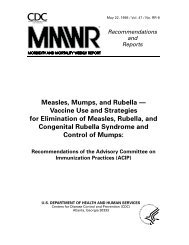(1) Welcome by INCLEN Chair - The INCLEN Trust
(1) Welcome by INCLEN Chair - The INCLEN Trust
(1) Welcome by INCLEN Chair - The INCLEN Trust
- No tags were found...
Create successful ePaper yourself
Turn your PDF publications into a flip-book with our unique Google optimized e-Paper software.
see value added and they must see that the barriers are eliminated or minimized<br />
for both real and perceived.<br />
<strong>The</strong>re must be 2-3 persons that will become the champion and push some<br />
quality projects through the CLEN. After breakthrough, the barriers will start to<br />
come down. Even though there are many countries, a few successes will mean<br />
the beginning of some synergy. This will all revolve around the existence of<br />
capacity and a broad based funder.<br />
What happened to the 300K. <strong>The</strong> money is still there. Site visits to Kenya and<br />
Zambia, try out an IPEN type model and they visited several other sites. Initial<br />
response was lukewarm. <strong>The</strong>y responded to action.. Institute of social research<br />
responded and UNICEF and DFID responded and they launched. Kenya was<br />
silent. <strong>The</strong>re is so much money for HIV and with PEPFAR. Malawi needs to be<br />
processed as a CEU. This is a legitimate concern and needs to be acted upon.<br />
<strong>The</strong>re is a significant lack of trained members in the critical areas of Malaria, HIV,<br />
and TB. We need to pursue how we can meet these needs with the high level<br />
capacity building that makes <strong>INCLEN</strong> strong. <strong>INCLEN</strong> Africa has developed a<br />
mentor/mentee workshop that is based upon the LAMP module. This is being<br />
further developed into a training workshop with the ultimate goal to have a<br />
Master Course in this area.<br />
e. IndiaCLEN IPEN<br />
Members will be joining IndiaCLEN as members. See slides for additional<br />
materials. USAID is the primary supporter. How many of the researchers spend<br />
75% of time. None. CEU outside of medical group. Is there room for the NGO<br />
who are not within the framework of Medical college or hospitals. Would we now<br />
have room for non physicians.<br />
What makes IndiaCLEN different from others Clear mission statement,<br />
organized managers, we should stay with either. <strong>The</strong> formation of thematic lines<br />
and groups is an advantage, excellent relationship with the health department<br />
and researchers. It is hard to determine what the reason for success is. What<br />
can IndiaCLEN do for the other CLENs. KT will take it back to the GB and they<br />
can take it under advisement. What are the differenced and what is the impact.<br />
<strong>The</strong>re was significant discussion about the move from medical University based<br />
CEUs to the IndiaCLEN recommended NGOs. <strong>The</strong> <strong>by</strong>e-laws would have to be<br />
the ultimate decision but perhaps it was time to revise. <strong>The</strong>re was concern about<br />
the criteria outside of the university structure which provides a mechanism for<br />
training and funds transfer/management.<br />
<strong>The</strong> autonomy of the CLENs was also discussed. If a CLEN in good faith<br />
presents a site for CEU status and the BOT declines, what will happen. Is the<br />
BOT the ultimate decision maker or just a certifying body. <strong>The</strong> group agreed to

















